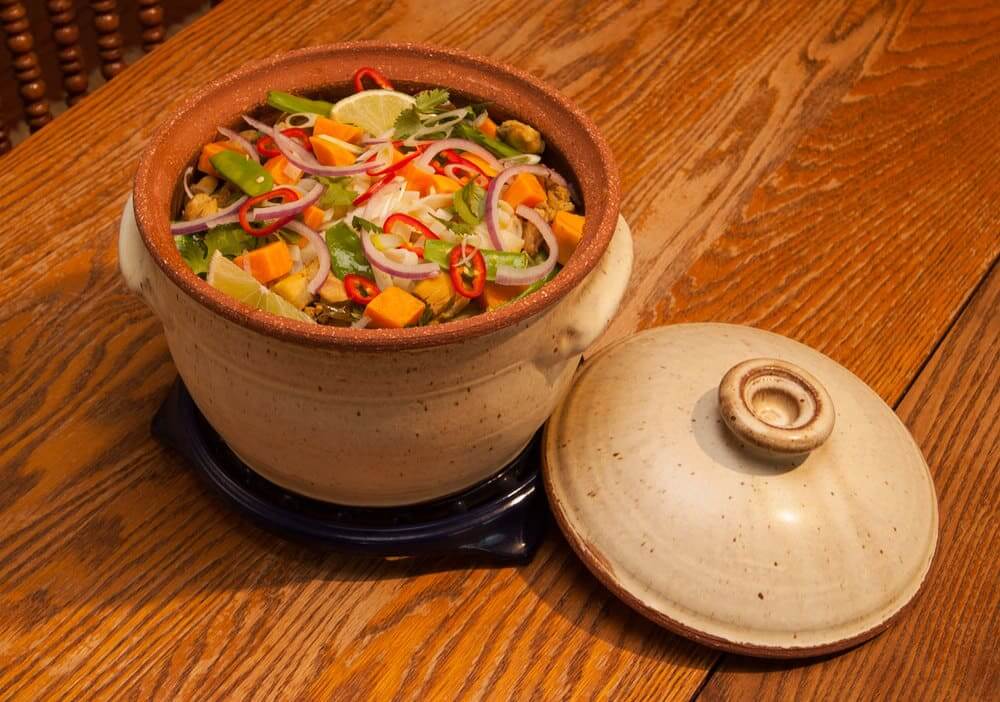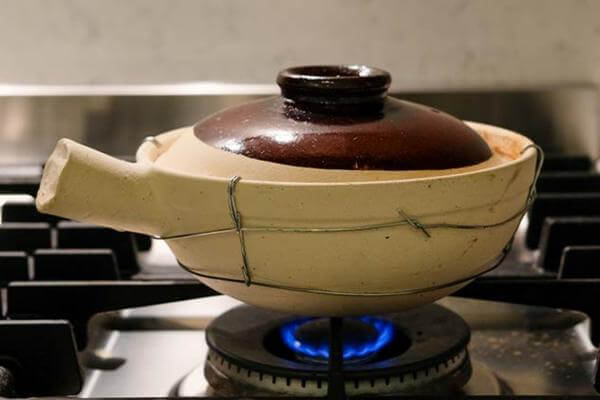Cooking with clay pots has been a culinary practice for thousands of years and is still popular today. Clay pots are not only aesthetically pleasing but also have many benefits when it comes to cooking. One question that people often ask is whether clay pots can be used on a gas stove.
The good news is that clay pots can be used on gas stoves, providing many benefits that other cookware cannot. Clay pots are known for their ability to absorb heat without scorching or burning, and they heat up more than metal pots, which allows for greater control.
This article explores the benefits of using clay pots on gas stoves, the types suitable for gas stoves, ideal temperature settings, how to use and maintain clay pots, and things to remember when cooking with clay pots on a gas stove. Following the recommended tips, you can enjoy tasty, healthy, eco-friendly meals using clay pots on your gas stove.
Benefits of Using Clay Pots on Gas Stoves
Using clay pots on gas stoves can provide numerous benefits that other cookware cannot. Here are eight benefits of using clay pots on gas stoves:
- Tastier and healthier food: The alkaline properties of clay can enhance the flavor of food and make it tastier. Additionally, clay pots maintain 100% nutrition in food, making it healthier.
- Reduced oil usage: Clay pots require less oil for cooking as they retain moisture and distribute heat evenly throughout the food.
- Retained heat: Clay pots retain heat for longer, even after the gas is turned off, allowing for a longer cooking time and less energy usage.
- Uniform cooking: Clay pots provide uniform cooking, preventing hot spots that can overcook or burn food.
- Eco-friendly: Clay pots are environmentally friendly, made of natural materials, and do not release toxic chemicals or gases when heated.
- Versatile: Clay pots can be used for a variety of cooking methods, including frying, boiling, steaming, and baking.
- Durable: Clay pots can last for years with proper care and maintenance.
- Aesthetic appeal: Clay pots add a rustic and traditional touch to any kitchen, making them a beautiful addition to your cookware collection.
What Types of Clay Pots Can I Use on the Gas Stove?
When it comes to using clay pots on gas stoves, it is important to choose the right type of clay pot to ensure that it is safe and effective for use. Here are some types of clay pots that are suitable for use on gas stoves:
Flameware Clay Pots

Flameware clay pots are made of a special type of clay that can withstand high temperatures without cracking or breaking. These pots are ideal for gas stoves as they can handle direct heat.
Pure Ceramic Pots

Top-quality pure ceramic pots, such as Xtrema 100 ceramic, are also suitable for gas stoves. These pots are made of natural, non-toxic materials and can withstand high temperatures without cracking.
It is important to note that not all types of clay pots are suitable for use on gas stoves. Some types of clay pots are designed for use on electric stovetops only, while others may not be able to handle the high temperatures of a gas stove. Always check the manufacturer’s instructions before using a clay pot on a gas stove to ensure that it is safe and effective for use.
What Temperature Setting Is Ideal When Using Clay Pots on Gas Stoves?
When using clay pots on gas stoves, choosing the right temperature setting is important to ensure that your food cooks evenly and your pot is not damaged. Here are some guidelines for temperature settings when using clay pots on gas stoves:
Medium-low heat
Medium-low heat is ideal for cooking with clay pots on gas stoves. This allows the pot to heat up gradually and evenly, preventing hot spots that can cause the food to burn or stick to the pot.
Start on low heat
If you use a clay pot for the first time, it’s best to start cooking on low heat and gradually increase the temperature as needed. This allows the pot to warm up gradually and helps prevent cracking or damage to the pot.
Use a well-seasoned pot
If you are using a well-seasoned clay pot, you can start cooking on medium-low heat if there are lots of liquids in the pot. Heat makes a well-seasoned pot less likely to crack or be damaged.
By choosing the right temperature setting and following these guidelines, you can ensure that your food is cooked evenly and your clay pot is not damaged when using it on a gas stove.
How to Use Clay Pots on Gas Stoves?

If you are interested in using clay pots on your gas stove, it is important to follow the right steps to ensure that your food cooks evenly and your pot is not damaged. Here are some guidelines for using clay pots on gas stoves:
- Soak the pot: Before using your clay pot for the first time, soak it in cold water for at least 15 minutes. This helps prevent the pot from cracking or breaking when it comes into contact with heat.
- Choose the right burner: When placing your clay pot on the gas stove, choose a burner that is the same size or slightly larger than the bottom of your pot. This helps ensure that the heat is evenly distributed.
- Start on low heat: When you’re ready to cook, start on low heat and gradually increase the temperature as needed. This allows the pot to warm up gradually and helps prevent cracking or damage to the pot.
- Use a potholder: When serving food from your clay pot, place it on a potholder or trivet. This helps prevent the pot from coming into direct contact with a cold surface, which can cause it to crack.
- Allow the pot to cool: After cooking, allow it to cool down to room temperature before cleaning it. This helps prevent the pot from cracking due to rapid temperature changes.
Following these guidelines, you can confidently use your clay pot on your gas stove and enjoy delicious, healthy meals cooked evenly and carefully.
Maintenance Tips for Clay Pots
Proper maintenance is essential for keeping your clay pots in good condition and ensuring they provide delicious, healthy meals. Here are some tips for maintaining your clay pots:
- Soak and scrape: After using your clay pot, soak it in water for a few minutes to soften any food residue. Then, gently scrape off any remaining food using a coconut scraper or a soft-bristled brush.
- Clean with baking soda: To remove any stubborn stains or odors, fill the clay pot with warm water and a tablespoon of baking soda. Let it sit for a few hours or overnight, then scrub the pot with a soft-bristled brush and rinse it thoroughly with water.
- Use vinegar for tough stains: For especially stubborn stains, mix equal parts white vinegar and water to soak the pot for a few hours or overnight. Then, scrub the pot gently and rinse it thoroughly with water.
- Avoid harsh chemicals: Avoid using harsh chemicals or abrasive sponges on your clay pots, as they can damage the pot’s surface and affect the taste of your food.
- Store properly: When storing your clay pots, make sure they are completely dry and free of any food residue. Store them in a dry, cool place, away from direct sunlight or heat.
- Handle with care: Clay pots are delicate and can easily crack or break. Handle them carefully, and avoid exposing them to sudden temperature changes or dropping them.
- Season your clay pot: Seasoning your clay pot before use can help prevent sticking and improve the flavor of your food. To season your pot, soak it in water for a few hours, then rub the inside with a garlic clove or a piece of ginger. Rinse the pot and let it dry completely before using.
- Avoid extreme temperature changes: Clay pots are sensitive to extreme temperature changes and can crack or break if exposed. Avoid placing a hot pot in cold water or putting a cold pot directly on a hot stove.
- Use a potholder: When serving food from your clay pot, use a potholder or trivet to protect your hands and surfaces from the heat.
- Replace damaged pots: If your clay pot is cracked or chipped, it’s best to replace it rather than try to repair it. Damaged pots can affect the taste of your food and may not cook evenly.
By following these maintenance tips, you can keep your clay pots in good condition and continue to enjoy delicious, healthy meals cooked in them for years to come.
Things to Remember When Cooking with Clay Pots on Gas Stove
When cooking with clay pots on a gas stove, there are a few things to keep in mind to ensure the best results and avoid damaging your pot:
- Avoid sudden temperature changes: As mentioned earlier, clay pots are sensitive to sudden temperature changes. Do not place a cold pot on a hot stove or expose a hot pot to cold water. Instead, let the pot cool down gradually before washing it.
- Do not use high heat: Clay pots heat up quickly and retain heat well, so it’s best to use low to medium-low heat settings when cooking with them. Using high heat can cause the pot to crack or break and may burn your food.
- Pre-soak the pot: Before using your clay pot for the first time, soak it in water for at least an hour. This will help prevent the pot from cracking during use. You can also soak the pot for 15 minutes before adding food to it to prevent it from sticking.
- Use a diffuser: Using a heat diffuser on your gas stove can help distribute heat evenly and prevent hot spots that can cause the pot to crack or burn your food. Place the diffuser between the pot and the stove and adjust the heat to the desired level.
- Handle the pot with care: Clay pots can be heavy, and the handles can get hot during cooking. To avoid burning yourself, use oven mitts or a potholder when handling the pot.
- Avoid abrasive cleaners: Harsh detergents and abrasive scrubbers can damage the clay surface of your pot. Instead, clean the pot with a soft sponge or cloth and mild dish soap.
- Use wooden or silicone utensils: Metal utensils can scratch the surface of your clay pot, causing it to weaken and crack over time. Use wooden or silicone utensils instead to avoid damaging the pot.
- Store the pot properly: When not in use, store your clay pot in a cool, dry place. Do not stack heavy items on top of it, which can cause the pot to crack or break.
- Re-season the pot occasionally: Over time, the seasoning on your clay pot may wear off, which can cause food to stick to the pot. Re-season the pot by rubbing a small amount of oil onto the surface and heating it on low heat for a few minutes.
- Check for cracks: Inspect your clay pot for cracks or chips before using it. Do not use a damaged pot, as it can break during cooking and may pose a safety hazard.
By following these tips, you can enjoy delicious and healthy meals cooked in a clay pot on your gas stove for years to come.
Best Clay Pot for Cooking on Gas Stove
Earthen Clay Cooking Pot
This simple, affordable clay pot is perfect for everyday cooking. It is made from clay known for its durability and heat retention. The pot is also dishwasher-safe, making it easy to clean.
Pros:
- Affordable
- Durable
- Heat-resistant
- Dishwasher safe
Cons:
- Not oven safe
- Can be heavy
Traditional Clay Terracotta Casserole
This versatile clay pot can be used for various dishes, from stews to casseroles. It is made from clay known for its ability to withstand high temperatures. The pot also has a glazed finish, which helps to prevent food from sticking.
Pros:
- Versatile
- Durable
- Heat-resistant
- Glazed finish
Cons:
- Not oven safe
- Can be heavy
Ancient Cookware, Oval Chamba Casserole
This is a high-quality clay pot that is perfect for slow cooking. It is made from a type of clay that is known for its ability to evenly distribute heat. The pot also has a tight-fitting lid, which helps to keep the food moist.
Pros:
- High-quality
- Even heat distribution
- Tight-fitting lid
Cons:
- Expensive
- Not dishwasher safe
- Can be heavy
Overall, the best clay pot for a gas stove will depend on your needs and budget. The Earthen Clay Cooking Pot is a good option if you are looking for an affordable, everyday pot. If you are looking for a versatile pot that can be used for various dishes, the Traditional Clay Terracotta Casserole is a good choice. And if you are looking for a high-quality pot for slow cooking, the Ancient Cookware Oval Chamba Casserole is a good option.
How to Season Clay Pot for The First Time?
Here are the steps on how to season a clay pot for the first time:
- Clean the clay pot thoroughly. Use a mild dish soap and warm water to wash the clay pot inside and out. Be sure to rinse it thoroughly and dry it with a clean towel.
- Soak the clay pot in water. Fill a large pot with water and submerge the clay pot completely. Soak the clay pot for at least 12 hours, or overnight.
- Drain the clay pot and dry it. Once the clay pot has soaked for at least 12 hours, drain it and dry it with a clean towel.
- Apply a thin layer of oil to the clay pot. Use a high-heat cooking oil, such as vegetable oil, canola oil, or peanut oil. Apply a thin layer of oil to the inside and outside of the clay pot, using a paper towel or your fingers.
- Heat the clay pot on the stovetop. Heat the clay pot over medium heat for 5-10 minutes. This will help the oil to polymerize and create a non-stick coating on the inside of the clay pot.
- Let the clay pot cool completely. Once the clay pot has cooled completely, it is ready to use.
Tips for seasoning a clay pot:
- Use mild dish soap and warm water to clean the clay pot. Do not use harsh detergents or abrasive scrubbers, as these can damage the clay pot.
- Soak the clay pot for at least 12 hours or overnight. This will help to remove any impurities from the clay pot and make it easier to season.
- Apply a thin layer of oil to the clay pot. Use high-heat cooking oil, such as vegetable, canola, or peanut. A thin layer of oil is all that is needed.
- Heat the clay pot on the stovetop over medium heat for 5-10 minutes. This will help the oil to polymerize and create a non-stick coating on the inside of the clay pot.
- Let the clay pot cool completely before using it.
How to care for a seasoned clay pot:
- After each use, wash the clay pot with warm water and mild dish soap.
- Do not use harsh detergents or abrasive scrubbers, as these can damage the seasoning.
- Dry the clay pot thoroughly after washing.
- Do not store the clay pot in a humid environment.
- Reseason the clay pot every few months, or more often if used frequently.
Is Clay Pot Cooking Healthy?
Yes, clay pot cooking is considered a healthy way to cook food. Clay pots are porous, which allows the heat to circulate evenly throughout the pot, cooking the food slowly and evenly. This helps preserve the nutrients in the food and prevents the food from drying out. Additionally, clay pots are alkaline, which helps to neutralize the acidity in food, making it easier to digest.
Here are some of the health benefits of clay pot cooking:
- Preserves nutrients: Clay pots are porous, which allows the heat to circulate evenly throughout the pot. This helps preserve the food’s nutrients, such as vitamins, minerals, and antioxidants.
- Lowers fat content: Clay pots do not require a lot of oil or fat to cook food, which can help lower the food’s fat content.
- Makes food more flavorful: Clay pots can add a subtle flavor to food, making it more flavorful.
- Improves digestion: Clay pots are alkaline, which helps to neutralize the acidity in food. This can make it easier to digest and help reduce inflammation.
Closing Thoughts
Using clay pots on gas stoves can be a wonderful way to cook delicious and healthy meals while enjoying the many benefits of clay cookware. By choosing the right type of clay pot, using the correct temperature settings, and properly maintaining the pot, you can enjoy cooking with it for years to come.
Remember to follow the recommended tips and take good care of your clay pot to prevent cracking, enhance its longevity, and maximize your cooking experience. With some practice and patience, you can become a pro at cooking with clay pots on gas stoves.
So, next time you are in the mood for a home-cooked meal, consider using a clay pot on your gas stove to elevate your cooking game.






